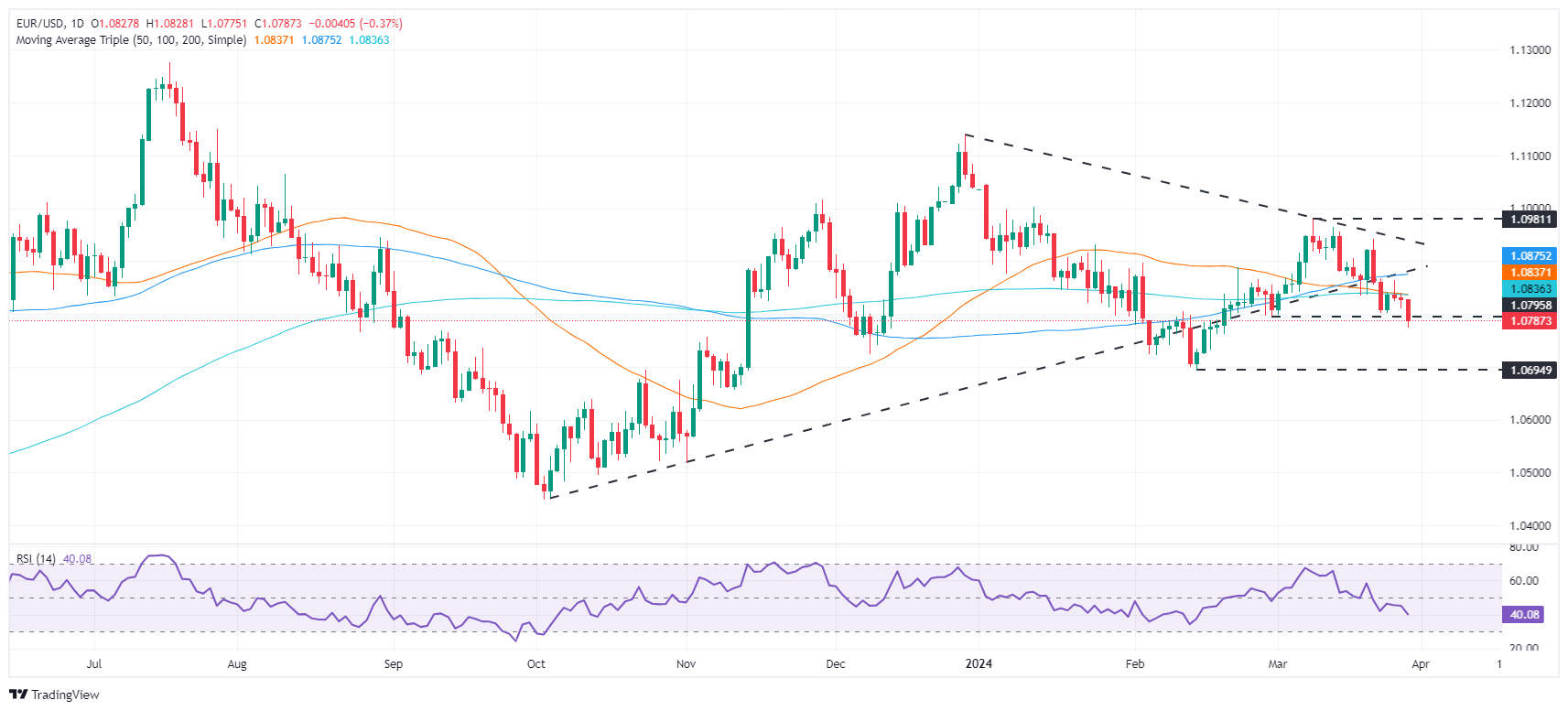- EUR/USD faces bearish pressure after ECB's Villeroy underlines the need to cut rates to meet inflation targets.
- The good economic results of the US, highlighted by the revision of GDP growth and the maintenance of the rigidity of the labor market, serve as support for the Dollar.
- Anticipation is growing in the markets regarding the upcoming publication of the US core PCE price index, with possible implications for the Fed's monetary policy.
The Euro extends its losses against the US Dollar, with the main currency falling below the 1.0800 level, following dovish comments from the head of monetary policy of the European Central Bank (ECB), Francois Villeroy. The EUR/USD pair is trading at 1.0787, down 0.37%.
EUR/USD fails under pressure from ECB rate cut hints
Comments from the ECB's Villeroy increased the selling momentum for EUR/USD at the end of the North American session. He said the decline in core inflation is rapid but remains high. He added that the ECB's 2% inflation target is within reach, while he saw downside risks increasing if the ECB does not cut rates. Turning to Eurozone data, German retail sales fell below estimates.
The latest data from the United States showed that the economy remains resilient after the Gross Domestic Product (GDP) for the fourth quarter of 2023 was revised from 3.2% to 3.4%. Other data showed that the number of Americans filing for unemployment benefits fell below estimates and the previous week's data for the fourth consecutive week, indicating tightness in the labor market.
Other data revealed that consumer sentiment from the University of Michigan reached its highest level since 2021, standing at 79.4, above the preliminary estimate of 76.5. Meanwhile, pending home sales rose 1.6% month-over-month in February, beating expectations.
Given the context, along with Federal Reserve Governor Christopher Waller's hawkish comments, they were the drivers of US Dollar bulls, who intervened ahead of the release of Core Personal Consumption Expenditure Price Index data. (PCE) of the United States.
EUR/USD Price Analysis: Technical Outlook
After dipping below the 200-day moving average (DMA), the EUR/USD pair has resumed the downtrend, breaking below the February 29 cycle low at 1.0794 and declining towards the 1.0780 area. If the pair sees a daily close below 1.0800, it will compound the challenge of the February 14 low at 1.0694, ahead of 1.0600.
In another scenario, if EUR/USD buyers lift the pair above 1.0800, this could pave the way to test the 200-DMA at 1.0835.

Frequently asked questions about the Euro
The Euro is the currency of the 20 countries of the European Union that belong to the Eurozone. It is the second most traded currency in the world, behind the US dollar. In 2022, it accounted for 31% of all foreign exchange transactions, with an average daily volume of more than $2.2 trillion per day. EUR/USD is the most traded currency pair in the world, accounting for an estimated 30% of all transactions, followed by EUR/JPY (4%), EUR/GBP (3%) and EUR/AUD (2% ).
The European Central Bank (ECB), headquartered in Frankfurt, Germany, is the reserve bank of the euro zone. The ECB sets interest rates and manages monetary policy. The ECB's main mandate is to maintain price stability, which means controlling inflation or stimulating growth. Its main instrument is to raise or lower interest rates. Relatively high interest rates – or the expectation of higher rates – tend to benefit the Euro and vice versa. The Governing Council of the ECB makes monetary policy decisions at meetings held eight times a year. Decisions are made by the heads of the eurozone's national banks and six permanent members, including ECB President Christine Lagarde.
Eurozone inflation data, measured by the Harmonized Index of Consumer Prices (HICP), are important econometric data for the Euro. If inflation rises more than expected, especially if it exceeds the ECB's 2% target, it forces the ECB to raise interest rates to bring it back under control. Relatively high interest rates compared to their peers tend to benefit the Euro, as it makes the region more attractive as a place for global investors to park their money.
The publication of economic data measures the health of the economy and can influence the value of the Euro. Indicators such as GDP, manufacturing and services PMIs, employment and consumer sentiment surveys can influence the direction of the single currency. A strong economy is good for the Euro. Not only does it attract more foreign investment, but it may encourage the ECB to raise interest rates, which will directly strengthen the Euro. Otherwise, if economic data is weak, the Euro is likely to fall. The economic data for the four largest economies in the Eurozone (Germany, France, Italy and Spain) are especially significant, as they represent 75% of the Eurozone economy.
Another important publication for the Euro is the trade balance. This indicator measures the difference between what a country earns from its exports and what it spends on imports during a given period. If a country produces highly sought-after export products, its currency will appreciate due to the additional demand created by foreign buyers wishing to purchase those products. Therefore, a positive net trade balance strengthens a currency and vice versa for a negative balance.
Source: Fx Street
I am Joshua Winder, a senior-level journalist and editor at World Stock Market. I specialize in covering news related to the stock market and economic trends. With more than 8 years of experience in this field, I have become an expert in financial reporting.





